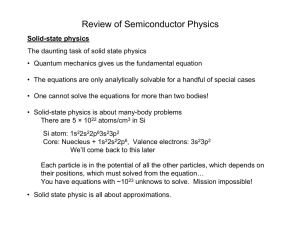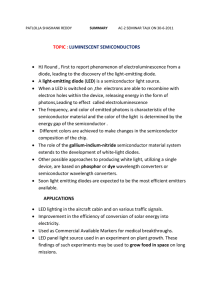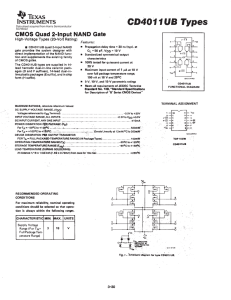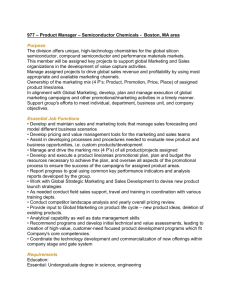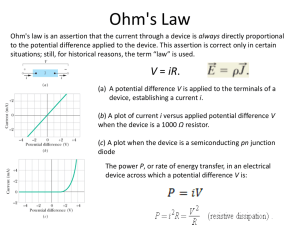Microelectronics Manufacturing: The Nigerian Content Academic Journal of Interdisciplinary Studies
advertisement
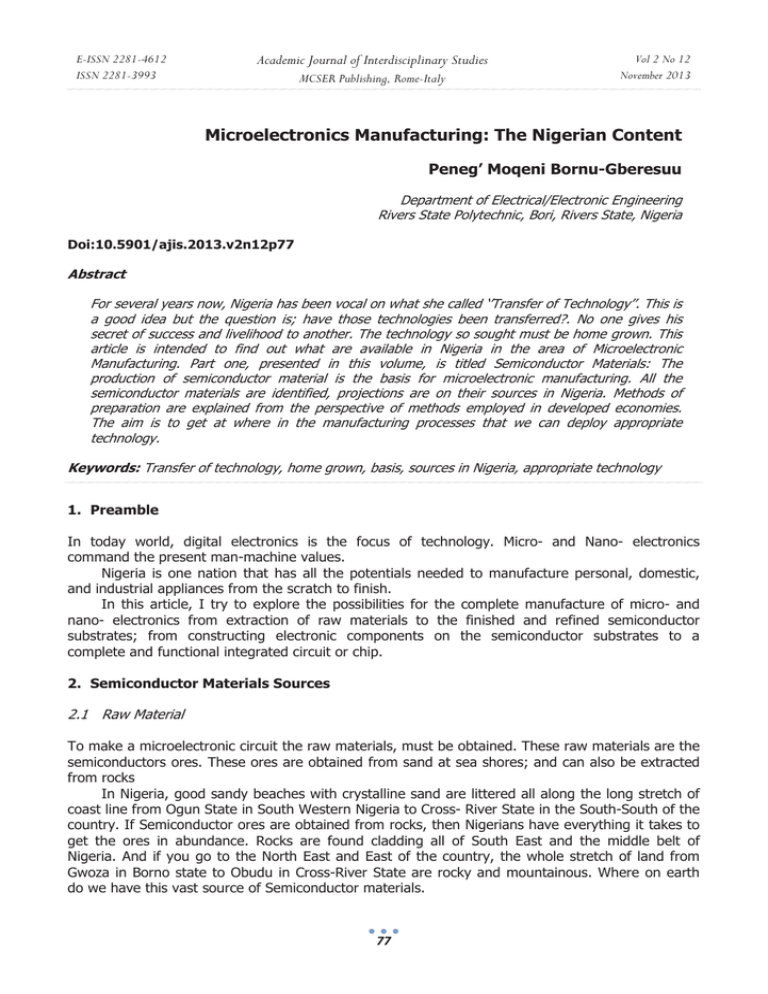
E-ISSN 2281-4612 ISSN 2281-3993 Academic Journal of Interdisciplinary Studies MCSER Publishing, Rome-Italy Vol 2 No 12 November 2013 Microelectronics Manufacturing: The Nigerian Content Peneg’ Moqeni Bornu-Gberesuu Department of Electrical/Electronic Engineering Rivers State Polytechnic, Bori, Rivers State, Nigeria Doi:10.5901/ajis.2013.v2n12p77 Abstract For several years now, Nigeria has been vocal on what she called ‘’Transfer of Technology’’. This is a good idea but the question is; have those technologies been transferred?. No one gives his secret of success and livelihood to another. The technology so sought must be home grown. This article is intended to find out what are available in Nigeria in the area of Microelectronic Manufacturing. Part one, presented in this volume, is titled Semiconductor Materials: The production of semiconductor material is the basis for microelectronic manufacturing. All the semiconductor materials are identified, projections are on their sources in Nigeria. Methods of preparation are explained from the perspective of methods employed in developed economies. The aim is to get at where in the manufacturing processes that we can deploy appropriate technology. Keywords: Transfer of technology, home grown, basis, sources in Nigeria, appropriate technology 1. Preamble In today world, digital electronics is the focus of technology. Micro- and Nano- electronics command the present man-machine values. Nigeria is one nation that has all the potentials needed to manufacture personal, domestic, and industrial appliances from the scratch to finish. In this article, I try to explore the possibilities for the complete manufacture of micro- and nano- electronics from extraction of raw materials to the finished and refined semiconductor substrates; from constructing electronic components on the semiconductor substrates to a complete and functional integrated circuit or chip. 2. Semiconductor Materials Sources 2.1 Raw Material To make a microelectronic circuit the raw materials, must be obtained. These raw materials are the semiconductors ores. These ores are obtained from sand at sea shores; and can also be extracted from rocks In Nigeria, good sandy beaches with crystalline sand are littered all along the long stretch of coast line from Ogun State in South Western Nigeria to Cross- River State in the South-South of the country. If Semiconductor ores are obtained from rocks, then Nigerians have everything it takes to get the ores in abundance. Rocks are found cladding all of South East and the middle belt of Nigeria. And if you go to the North East and East of the country, the whole stretch of land from Gwoza in Borno state to Obudu in Cross-River State are rocky and mountainous. Where on earth do we have this vast source of Semiconductor materials. 77 E-ISSN 2281-4612 ISSN 2281-3993 Academic Journal of Interdisciplinary Studies MCSER Publishing, Rome-Italy Vol 2 No 12 November 2013 2.2 Semiconductor Materials Listed here are some of the semiconductor materials that researches have proven to be useful in the electronic industry. 2.2.1 Bismuth Telluride. (Bi2Te3) Bismuth occurs in nature, but often associated with silver, gold, etc. It has a complex rhombohedral structure and exhibits very anisotropic thermal and electrical properties. Used primarily as a thermoelectric material. It is a compound of bismuth and tellurium. 2.2.2 Boron. (B) Thius coccurs naturally in borates and in the silicates:- tourmaline, axinite and datolite.This is a very hard material with a dark, non-metallic lustre. Presently there are three crystallographic modifications - (i) Low Temperature α - rhombohedral (ii) Tetragonal, (iii) High Temperature ߚ rhombohederal. Boron has high activation energy hence its use as a thermistors material. 2.2.3 Cadmium Sulphide (CdS) Cadmium occurs in nature as the sulphide, greenockite, zinc ores. It is brittle and can be found in any colour even transparent depending on the kind and amount of impurities present. The cubic form is unstable. The hexagonal modification is stable. These are the only two modifications, this semiconductor material is used as thin- film photoconductor. Used also in light meters and various 78 E-ISSN 2281-4612 ISSN 2281-3993 Academic Journal of Interdisciplinary Studies MCSER Publishing, Rome-Italy Vol 2 No 12 November 2013 other optical sensors designed to operate in the physical spectrum. It can also be used in solar cell. It is a compound semiconductor material. 2.2.4 Diamond (D) This occurs in igneous rocks and in alluvial deposits. There are two types:- type I-behaves as an insulator. Though type II is rare, it is considered semiconductor material,. It has the p-type material property .It is used occasionally as mounting blocks for high –power semiconductor devices. 2.2.5 Gallium Arsenide (GaAs) Gallium (Ga) is obtained as a bye-product of bauxite refining. Arsenic occurs in many sulphide ores. A compound semiconductor material, it is a dark gray material with Zinc blende structure used in high-temperature transistor material. Other applications include Varactor Diodes, Schottky Barrier Diodes, Light Emitting Diodes etc. It is. 2.2.6 Germanium (G) A brittle silvery gray metallic element It is a p-type semiconductor material. Its use in diodes and transistors is declining. Used mostly in devices which require very low— forward - voltage drop . For instance low-voltage inverter application. 2.2.7 Gray Tin Tin is found in Nigeria in cassiterites or tinstone. Casseterite is obtained from lodes and alluvial deposits. Here, there are two modifications 79 E-ISSN 2281-4612 ISSN 2281-3993 (i) (ii) Academic Journal of Interdisciplinary Studies MCSER Publishing, Rome-Italy Vol 2 No 12 November 2013 Gray semiconductor cubic (α) form stable below 13.20 C A metallic white dragooned structure ߚ form that is stable above 13.20 C up to its melting point of 231.9o C 2.2.8 Indium Antimonite (InSb) Indium is obtained as a bye-product of smelting and refining lead, zinc, tin and copper. Antimony occurs as sulphide, antimonite (Sb2S3) or stibnite. It is a bright shiny material. The primary use is in the production of photovoltaic infrared detectors. It can also be used in the photoconductive mode. Because of its high magneto-resistive effect it is used in various displacement gages and variable resistors; flux meters and analog multipliers 2.2.9 Lead Sulphide (PbS) Is a dark metallic appearing material which occurs naturally as large crystal called galena. Deposits of galena oxidize in their upper parts into oxysalts; eg. Cerussite (PbCO3), and anglesite (PbSO4). Lead occurs as lodes or veins. Used as an RF and infrared detectors. 2.2.10 Selenium (Se) It occurs in sulphide and all pyritic ores. Found in monoclinic, hexagonal and atmospheric forms. The monoclinic form has α and ߚ modifications. The Hexagonal form is gray or metallic-looking and consists of zigzag chains running parallel to the z-axis. Used in rectifiers and photoconductive application. The amorphous form softens from 50o C and flows at 100o C 80 E-ISSN 2281-4612 ISSN 2281-3993 Academic Journal of Interdisciplinary Studies MCSER Publishing, Rome-Italy Vol 2 No 12 November 2013 2.2.11 Silicon (Si) Silicon is found as silica (SiO2) and occurs as quartz, chaldcedony, agate, flint etc. It is brittle and hardness is rated intermediate between germanium and quartz. It is used in the production of integrated circuits, rectifiers, diodes, transistors, SCRs and triacs; solar cells, positive temperature coefficient resistors. 2.2.12 Silicon Carbide (SiC) This is an alloy of silicon and carbon. But occurs naturally only in meteor specimens. It may have the colour of black, green, orange or pale blue or virtually clear, used mostly as heat sink for lightpower semiconductor devices. It decomposes at 2830o C at atmospheric pressure.it does not melt to a molten state. 2.2.13 Tellurium Thus occurs in nature, but mostly combined with bismuth, lead, gold, or silver. It is a white, metallic- looking element used in thin-film transistors and as content of various semiconductor components. Draining from the list of semiconductor materials above, Boron, Diamond Germanium, Selenium, Silicon and Tellurium are the only pure elements whose ores are naturally occurring by mere acetylene and oxygen flame and on charcoal. By their description one can make good identification at the preparation of the pure element. Others are alloys of their respective constituent elements. These elements can also be identified 3. Substrate Realisation Space failed me to discuss all the processes to realize the pure substrate of semiconductor material for each of the thirteen semiconductor materials listed in the last section so I have left out the 81 E-ISSN 2281-4612 ISSN 2281-3993 Academic Journal of Interdisciplinary Studies MCSER Publishing, Rome-Italy Vol 2 No 12 November 2013 compound semiconductors and concentrate on the pure semiconductors whose ores are readily available. 3.1 Boron Boron is extracted from a halide; that is, a salt of Boron and other metals like fluorine, chlorine, bromine, iodine and astatine. Notice that there elements are in the seventh group of element on the periodic table. The extraction process is that the halide (ore) is heated to a temperature of about 11000 C for α-rhombohedra, 13000 C for high-temperature and above 15000 C for ߚ – rhombohedra modification At each of those temperature the vapour from the halide (Boron Chloride, Boron-Fluoride, etc.) is collected above this vapour; solidifies to form Boron semiconductor material. 3.2 Diamond Diamond mines may not have been found in Nigeria, but found in other sister African countries. With good negotiation one can import same. 3.3 Germanium The process of extraction is: Germanium Chloride is obtained and hydrolysing it (ie adding ambient amount of water) to reduced it to Germanium Oxide (GeO2) and later reducing the oxide with hydrogen. 3.4 Selenium The one suspected of containing selenium is heated. It begins to softer at temperature from 500 to 600 C and flows at 1000 C for the amorphous form. The hexagonal form melts at 22170 C At the point of flow Selenium is decanted to a container where purification process begins. The purification process involves more stages of heating and decanting . 3.5 Silicon Silicon is not found naturally. It is found in various other minerals like silica and silicates. To make Silicon, quartz sand has to be reduced with coke. The product is converted to a halide like Silicon Tetrachloride or SiHCl3. The next step is to purify it by repeated distillation which is later reduced with hydrogen. This is done either of two methods: hydrogen reduction of SiHCl3 or SiCl4; or the thermal decomposition of SiH4. 3.6 Tellurium An element found in nature. Single crystals are grown by either the Czochralski or the Bridgeman method. It is purified by distillation. 4. Crystal Growth This article is not intended to deal with theories, rather, the thrust herein is to make a realizable approach to manufacturing microelectronic from the local content and by the use of appropriate technology in Nigeria Walter R. Bunyan and Stacy B. Watelski of Texas Instruments Incorporated, Dallas-Texas, 82 E-ISSN 2281-4612 ISSN 2281-3993 Academic Journal of Interdisciplinary Studies MCSER Publishing, Rome-Italy Vol 2 No 12 November 2013 USA in their contributing articles to Handbook of Material Processes for Electronics stated that most microelectronic devices require single- crystal semiconductors for best performances and that a number of processes are available, depending on the desired properties. 4.1 Crystal – Growing Environment Over the years there has been several methods adopted for crystal-growing. It is also noted that each of these methods have its own different sub methods. However, three main categories have been prominent. 1. Crystallization from One-Component System. This has not been done purely because of impurities. But then for practical purposes, it is agreed that process can go on. So these processes are possible. i. Crystallization from a liquid of the same composition ii. Crystallization from a vapour of the same composition. iii. Crystallization in the solid state. 2. Crystallization from a multicomponent system. The steps in item one is also followed. 3. Crystallization from a multicomponent system coupled with chemical reaction (s).The steps in item one is also followed. 5. Preparation of Semiconductor Materials Discussion here is centred on the preparation of two most commonly used semiconductors. 5.1 Preparation of Germanium The basic source of germanium is from zinc refining or from the flue dust of certain coals. Germanium has a gray metallic lustre. And because it is available in the oxide form (GeO2) it is easily treated with heat. 5.1.1 Primary processes. Step I: Heat Germanium Oxide to 6500 C in an atmosphere of hydrogen Result: Germanium is obtained as germanium powder (Ge) Step II: Heat Germanium (Ge) to above melting point of about 9370C Result: Germanium bars, but it is of low impurity type. 5.1.2 Secondary Processes 5.2 Float Zoning Process Step I: The germanium melt from the end of the primary process is kept in a graphitic pot lined internally by quarts liner. The ambient temperature is kept above melting temperature. Step II: A tout rod is obtained and a tiny seed of germanium is positioned at one end of the rod. Step III: Immerse the rod with the end holding the seed into the molten germanium Step IV: Rotate the rod (to promote stirring in the molten germanium) Step V: Slowly withdraw the rod with the seed as the liquid freezes on the colder seed. The technique here is that the growing crystal is raised at such a rate as to keep the interface between the solid and the liquid at the surface of the molten germanium 83 E-ISSN 2281-4612 ISSN 2281-3993 Academic Journal of Interdisciplinary Studies MCSER Publishing, Rome-Italy Vol 2 No 12 November 2013 Result: It is expected that the atoms in the solidified melt arrange themselves in such a way that they have the same crystal structure as the seed crystal. The grown crystal is usually circular and 2 to 3 cm in diameter. But several centimetres in length depending on construction length. 5.3 Doping for p-type and n-type Germanium The arrangement for crystal growth incorporates quartz tube through which donor or acceptor type impurities can be added to produce p-type or n-type germanium The process is done in the atmosphere of hydrogen-argon which is introduced through the side tube. 5.4 Preparation of Silicon Silicon has a bluish-grey metallic lustre. Though hard, its melting point is 14200 C. at 80o C it becomes ductile. The semiconductor is obtained in Silicon Hydro-Chloride (SiHCl3) or Silicon Tetra Chloride (SiCl4) or Silicon Hydride (SH4). 5.4.1 Primary Processes Step I: Depending on the type of quartz sand. Step II: SiHCl3 or SiCl4 or SiH4 is purified by repeated distillation Step III; or Pyrolytic decomposition of Silane (SiH4) or 5.4.2 Secondary Processes Any of the following methods are used here. Viz: Float zoning or zone level or Czochralski methods. Discussed fully in part three of this article. 6. Silicon Crystal Growth 6.1 Polycrystalline Silicon: A practical Approach Several methods are employed to produce semiconductor – grade polycrystalline silicon. Depending on the silicon ore obtained. The following four basic practical process steps are as follows: 1. Submerged – electrode arc furnace reduction of quartzite and carbon – reducing agent of coal, coke, and wood chips to metallurgical – grade silicon. If quartzite is SiO2 then the reduction process is SiO2 + 2C = Si + 2CO 84 E-ISSN 2281-4612 ISSN 2281-3993 Academic Journal of Interdisciplinary Studies MCSER Publishing, Rome-Italy Vol 2 No 12 November 2013 2. Conversion of metallurgical silicon by chlorination into trichcorosilane via a fluidization bed reaction with anhydrous HCL: Si + 3HCl = SiHCl3 + H2 3. This trichlorosilane (SiHCl3) is further subjected to severe purification processes. 4. Trichlorosilane (in this forth step is treated with Hydrogen in a process called chemical – Vapour Deposition. The process is; SiHCl3 + 2H2 = 6HCl + 2Si 6.2 Float – Zone Growth Silicon is heated to a molten state and drained into a vertical poly silicon rod. RF heating process is used to keep the silicon in molten state continuously. The molten zone is freely suspended by surface tension and RF levitation forces. In these process particles of the container does not contaminate the silicon to obtain exceptional purity. Float – zoning takes two processes, first process involves the molten zone is produced at the end of the silicon rod placed in a vacuum, the rod shown moved through its length to further purify the silicon rod. Here the impurities are segregated and by evaporation particularly the volatile one. The second process is carried out under partial pressure of an insert gas (argon). Here a seed crystal is attached to the lower end of a driven shaft and to slowly move the rod with the seed crystal vertically up, keeping the seed crystal always at the surface of the molten zone. This produces single crystal silicon. The driving shaft are rotated independently for uniform thermal distribution. 7. Czochralski Growth This process is similar to that of the process used for germanium. The only difference is that both the top rod and the base in Czochralski growth are rotated. The arrangement shall be treated in the third part of this article. 8. Compound Semiconductors A compound semiconductor is that in which two or more element are combined to form a single semiconductor material: The basic difference between the growth of elemental and compound semiconductors are as follows: 1. The difficulty of maintaining stoichiometry – the correct chemical ratio of the continent species, since one component is usually highly volatile than the other. 2. Achieving high crystalline perfection for semiconductor with lower thermal conductivities critical resolved shear stress, and stacking fault energies than elemental silicon, following are the techniques used for producing crystal of compound semiconductors. a. Purification and Synthesis Slowly reacting the two components in a thick walled quartz tube in a horizontal furnace. b. Horizontal Bridgeman/Gradient Freeze Techniques This usually is a two –step processes: i. By exothermic reaction in a sealed heavy – walled quartz tube. ii. A boat is loaded with the compound with its crystal seed at one end. This boat is contained in a heavy-walled quartz tube within a furnace. Moving the boat from low temperature to very high temperature. There are other method like vertical gradient freeze, Liquid – Encapsulated Czochralski Technique. 85 E-ISSN 2281-4612 ISSN 2281-3993 Academic Journal of Interdisciplinary Studies MCSER Publishing, Rome-Italy Vol 2 No 12 November 2013 9. Wafer Preparation Wafer specifications are varied: diameter, thickness, primary and secondary orientation, flats location, orientation (on- orientation or up to several degrees off- orientation, wafer flatness, etc. In another category issues like tapper and bow which are dictated by the use of sub-micrometer lithography are specified. I stated earlier that the molten mix is passed through crystallization process described earlier; forming a cylindrical ingot. To form wafers, the cylindrical ingot is cut with diamond saws into thin circular wafers. Some authorities quote the thickness of the wafer as between 250 to 400 ߤ݉ and put the diameter from 1 to 3 inches. 10. Conclusion I have touched on possible sources of semiconductor materials in Nigeria but the determination of what semiconductor comes out of which site is a matter of actually mining on a particular site. The presentation here is less of theories and focus is on the practical ways of realizing the goal of semiconductor materials production which will pave way for micro- and nano- electronics manufacture in Nigeria. The most approximate appropriate technological methods to achieve this objective shall be arrived at in subsequent researches and articles. References Charles A. Haper ( 1970), Handbook of Materials and Processes for Electronics 1st Edition, Mc-Graw – Hill, Maryland, Charles A. Harper and Ronald M. Sampson (1993), Electronic Materials and Processes Handbook. 2nd Edition, McGraw – Hill, Inc. Cheng T. Wang (1990), Introduction to Semiconductor Technology 1st Edition, John Wiley & Sons, Inc. Dal Koshal (1993), Manufacturing Engineer’s Reference Book 1st Edition, Butterworth Heinemann. C. D. Gribble, Rutley’s Elements of Mineralogy, 27th Edition CBS Publishers and distributors. 1988. Donald G. Fink and Donald Chriatiansen (1989), Electronic Engineers Handbook 3rd Edition, McGraw – Hill, Inc. Mark E. Hazen (1991), Exploring Electronic Devices 1st Edition, Sounders College Publishing, Florida, Paul Horowitz and Windfield Hill (1997), The Art of Electronics 2nd Edition, Cambridge University Press, Cambridge . R. J. Rajput (2004), Material Science and Engineering 3rd Edition, S. K. Kataria and Sons, Reprint: 2013 William F. Smith and Javad Hashemi (2006), Foundations of Materials Science and Engineering. 4th Edition, McGraw – Hill, Inc. Singapore, 86

